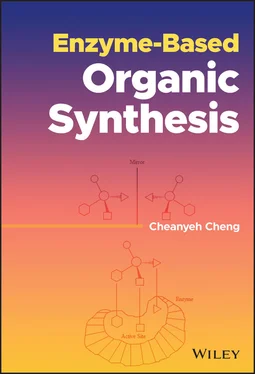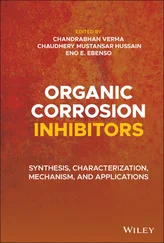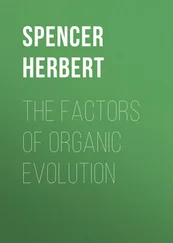Cheanyeh Cheng - Enzyme-Based Organic Synthesis
Здесь есть возможность читать онлайн «Cheanyeh Cheng - Enzyme-Based Organic Synthesis» — ознакомительный отрывок электронной книги совершенно бесплатно, а после прочтения отрывка купить полную версию. В некоторых случаях можно слушать аудио, скачать через торрент в формате fb2 и присутствует краткое содержание. Жанр: unrecognised, на английском языке. Описание произведения, (предисловие) а так же отзывы посетителей доступны на портале библиотеки ЛибКат.
- Название:Enzyme-Based Organic Synthesis
- Автор:
- Жанр:
- Год:неизвестен
- ISBN:нет данных
- Рейтинг книги:3 / 5. Голосов: 1
-
Избранное:Добавить в избранное
- Отзывы:
-
Ваша оценка:
- 60
- 1
- 2
- 3
- 4
- 5
Enzyme-Based Organic Synthesis: краткое содержание, описание и аннотация
Предлагаем к чтению аннотацию, описание, краткое содержание или предисловие (зависит от того, что написал сам автор книги «Enzyme-Based Organic Synthesis»). Если вы не нашли необходимую информацию о книге — напишите в комментариях, мы постараемся отыскать её.
An insightful exploration of an increasingly popular technique in organic chemistry Enzyme-Based Organic Synthesis
Enzyme-Based Organic Synthesis
Enzyme-Based Organic Synthesis
Enzyme-Based Organic Synthesis — читать онлайн ознакомительный отрывок
Ниже представлен текст книги, разбитый по страницам. Система сохранения места последней прочитанной страницы, позволяет с удобством читать онлайн бесплатно книгу «Enzyme-Based Organic Synthesis», без необходимости каждый раз заново искать на чём Вы остановились. Поставьте закладку, и сможете в любой момент перейти на страницу, на которой закончили чтение.
Интервал:
Закладка:
To encourage and propel the implementation of green chemistry, the Presidential Green Chemistry Challenge Award was established by the United States government in 1996. The following are several award winners that can be used as models in green chemistry by using enzyme and related microbe for production of chemicals [35].
The winner of year 2011: Production of Basic Chemicals from Renewable Feedstocks at Lower Cost
Genomatica has developed a microbe using sophisticated genetic engineering to make 1,4‐butanediol (BDO) (a high‐volume chemical building block used to make many common polymers, such as spandex) by fermenting sugars. When produced at commercial scale, Genomatica’s Bio‐BDO will be less expensive, require about 60% less energy, and produce 70% less carbon dioxide emissions than BDO made from natural gas.
1.7 The Winner of Year 2010: Greener Manufacturing of Sitagliptin Enabled by an Evolved Transaminase
Merck and Codexis have developed a second‐generation green synthesis of sitagliptin, the active ingredient in Januvia, a treatment for type 2 diabetes. This collaboration has led to an enzymatic process with transaminase that reduces waste, improves yield and safety, and eliminates the need for a metal catalyst. Early research suggests that the new biocatalysts will be useful in manufacturing other drugs as well.
1.8 The Winner of Year 2009: A Solvent‐Free Biocatalytic Process for Cosmetic and Personal Care Ingredients
Esters are an important class of ingredients in cosmetics and personal care products. Usually, they are manufactured by harsh chemical methods that use strong acids and potentially hazardous solvents; these methods also require a great deal of energy. Eastman’s new method uses immobilized enzymes to make esters, saving energy, and avoiding both strong acids and organic solvents. This method is so gentle that Eastman can use delicate, natural raw materials to make esters never before available.
References
1 1 Segal, I.H. (1975). Enzyme Kinetics. Behavior and Analysis of Rapid Equilibrium and Steady‐State Enzyme Systems. New York: Wiley.
2 2 Armstrong, F.B. (1989). Biochemistry. Oxford: Oxford University Press.
3 3 Silverman, R.B. (2002). The Organic Chemistry of Enzyme‐Catalyzed Reactions. Amsterdam: Academic Press.
4 4 Sumner, J.B. (1926). J. Biol. Chem. 69: 435–441.
5 5 Sumner, J.B.J. (1926). Boil. Chem. 70: 97–98.
6 6 Jabri, E., Carr, M.B., Hausinger, R.P., and Karplus, P.A. (1995). Science 268: 998–1004.
7 7 Jabri, E. and Karplus, P.A. (1996). Biochemistry 35: 10616–10626.
8 8 Hirs, C.H.W., Moore, S., and Stein, W.H. (1960). J. Biol. Chem. 235: 633–647.
9 9 Nelson, D.L. and Cox, M.M. (2000). Lehninger Principles of Biochemistry. New York: Worth Publishers.
10 10 Lubert, S. (1988). Biochemistry, Thirde. New York: W. H. Freeman and Company.
11 11 Mathews, C.K., van Holde, K.E., and Ahern, K.G. (2000). Biochemistry, Thirde. San Francisco: Addison Wesley Longman, Inc.
12 12 Zubay, G. (1988). Biochemistry, Seconde. New York: Macmillan Publishing Company.
13 13 Faber, K. (2004). Biotransformations in Organic Chemistry, A Textbook, Fifthe. Berlin: Springer‐Verlag Berlin Heidelberg.
14 14 Sweers, H.M. and Wong, C.‐H. (1986). J. Am. Chem. Soc. 108: 6421–6422.
15 15 Bashir, N.B., Phythian, S.J., Reason, A.J., and Roberts, S.M.J. (1995). Chem. Soc., Perkin Trans. 1: Org. Bio‐org. Chem 18: 2203–2222.
16 16 Dadd, M.R., Claridge, T.D.W., Walton, R. et al. (2001). Enz. Microbial Technol. 29: 20–27.
17 17 Takenaka, S., Mulyono, Sasano, Y. et al. (2006). J. Biosci. Bioeng. 102: 21–27.
18 18 Bustillo, A.J., García‐Pajón, C.M., Aleu, J. et al. (2003). Tetrahedron.: Asymmetry 14: 3755–3760.
19 19 Shimoda, K., Harada, T., Hamada, H. et al. (2007). Phtochem. 68: 487–492.
20 20 Dai, J., Ye, M., Guo, H. et al. (2002). Tetrahedron 58: 5659–5668.
21 21 Miyazawa, M., Sugie, A., and Shindo, M. (2002). Biosci. Biotechnol. Ciochem. 66: 2458–2460.
22 22 Miyazawa, M., Marumoto, S., Masuda, A. et al. (2009). J. Agric. Food Chem. 57: 7800–7804.
23 23 Sih, C.J. and Wu, S.‐H. (1989). Topics Stereochem. 19: 63–125.
24 24 Ogston, A.G. (1948). Nature 162: 963.
25 25 Jones, J.B. (1976). Biochemical Systems in Organic Chemistry: Concepts, Principles and Opportunities. In: Applications of Biochemical Systems in Organic Chemistry (ed. J.B. Jones, C.J. Sih and D. Perlman). New York: Part I. Wiley.
26 26 Zheng, J.‐Y., Wang, Z., Zhu, Q. et al. (2009). Mol. Catal. B 56: 20–23.
27 27 Lin, W.‐D., Chen, C.‐Y., Chen, H.‐C., and Hsu, W.‐H. (2010). Process Biochem. 45: 1529–1536.
28 28 Dorokhova, M.I., Somolina, N.E., Tikhonova, Y.O., and Mikhalev, V.A. (1974). Pharm. Chem. J. 8: 209–211.
29 29 Jia, X.; Xu, Y.; Li, Z. (2011) ACS Catal. 1, 591‐596.
30 30 Kula, M.‐R. (1995). Introduction. In: Enzyme Catalysis in Organic Synthesis: A Comprehensive Handbook, Volume I (ed. K. Drauz and H. Waldmann). New York: VCH Publishers, Inc.
31 31 Anstas, P. and Warner, J. (1998). Green Chemistry: Theory and Practice. New York: Oxford University Press.
32 32 Hill, J.W.; McCreary, T.W.; Kolb, D.K. (2010) Chemistry for Changing Times, Twelfth Edition, Pearson Education, Inc., New Jersey: Upper Saddle River.
33 33 Cheng, C., Chen, C.‐S., and Hsieh, P.‐H. (2010). J. Chromatogr. A 1217: 2104–2110.
34 34 Cheng, C. and Chang, K.‐C. (2007). Anal. Scis 23: 305–310.
35 35 FedCenter.gov. Presidential Green Chemistry Challenge Awards. https://www.fedcenter.gov/Bookmarks/index.cfm?id=1205&printable=1.
2 Organic Synthesis with Oxidoreductases
2.1 Oxidation Reactions
Enzymatic and microbial oxidations can be dated back to 2000 BCE with vinegar production that is based on the oxidation of ethanol by acetic acid bacteria. Enzymes involved in the biocatalyzed oxidations are dehydrogenases and oxidases. The more common coenzymes associated with dehydrogenases are nicotinamide adenine dinucleotide/nicotinamide adenine dinucleotide hydrogen (NAD +/NADH), nicotinamide adenine dinucleotide phosphate/nicotinamide adenine dinucleotide phosphate hydrogen (NADP +/NADPH), and flavin adenine dinucleotide/flavin adenine dinucleotide hydrogen (FAD/FADH 2), whereas oxidases are usually assisted by flavoproteins for transferring electrons to molecular oxygen. Dehydrogenases can be found in aerobic and anaerobic organisms or microorganisms; however, oxidases are not present in strictly anaerobic species. Nowadays, dehydrogenases and oxidases have been extensively used for selective oxidations and as an alternative synthetic strategy for conventional oxidations with the advantages of being environmentally friendly and highly chemo‐, regio‐, and stereoselective. Nevertheless, due to poor stability of the two enzymes at high substrate/product/organic solvent concentration and temperature, large‐scale bio‐oxidation processes were few. The functional groups involved in those bio‐oxidations include hydroxyls of primary and secondary alcohols, carbonyls of aldehydes, saturated C–C bonds, C–N bond of amino acids, amines, nitroalkanes, and thiols [1].
2.1.1 Oxidation of Alcohols and Aldehydes
Since primary alcohols can be oxidized to aldehydes and further to carboxylic acids, which are versatile building blocks in organic synthesis, the selective oxidation of primary alcohols using enzymes to produce corresponding aldehydes is important for both fundamental and industrial research. Benzaldehyde, which is important and widely applied in cosmetic, flavor, and pharmaceutical industries [2, 3], is generally prepared by oxidation of toluene or hydrolysis of benzyl chloride. Due to environmental concern, scientific reports have shown that Gluconobacter oxydans can be used for the selective oxidation of benzyl alcohol to obtain benzaldehyde in an organic/aqueous biphasic system to substitute for these environmentally unfavorable processes [4, 5]. Optimization of the immobilization parameters for G. oxydans not only improves the bioconversion of the selective oxidative process but also increases the stability of immobilized cells so that the immobilized cells can be used repeatedly for 10 cycles and a 53.2% of the oxidative activity of the immobilized cells compared with that of free cells was retained [6].
Читать дальшеИнтервал:
Закладка:
Похожие книги на «Enzyme-Based Organic Synthesis»
Представляем Вашему вниманию похожие книги на «Enzyme-Based Organic Synthesis» списком для выбора. Мы отобрали схожую по названию и смыслу литературу в надежде предоставить читателям больше вариантов отыскать новые, интересные, ещё непрочитанные произведения.
Обсуждение, отзывы о книге «Enzyme-Based Organic Synthesis» и просто собственные мнения читателей. Оставьте ваши комментарии, напишите, что Вы думаете о произведении, его смысле или главных героях. Укажите что конкретно понравилось, а что нет, и почему Вы так считаете.












